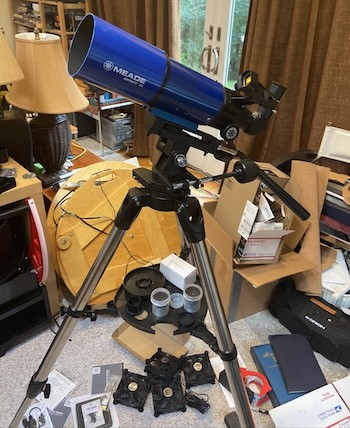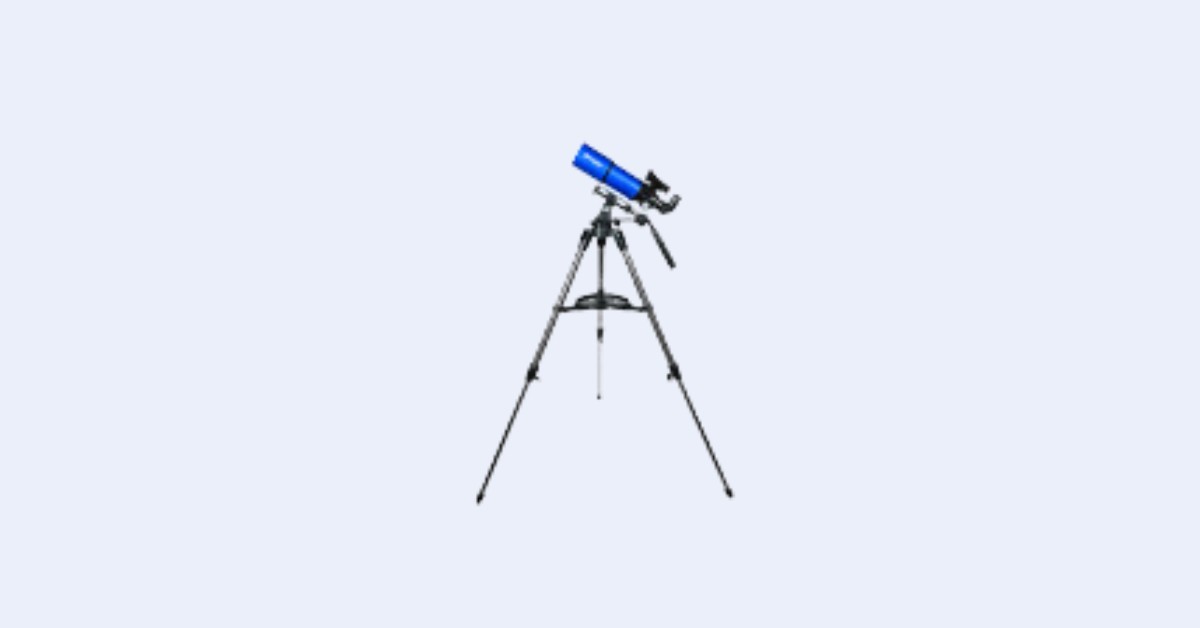Meade’s Infinity 80AZ is probably the cheapest serious tripod-mounted telescope I would really recommend to a novice. It offers extreme convenience, simplicity, and portability with the only drawback I’ve noticed is its poor planetary and double star performance. 80mm of aperture is also about the minimum size you really need to start getting into deep-sky observation.
Overview of The Infinity 80 Optical Tube
The Infinity 80 optical tube is identical to the sadly-discontinued Orion ShortTube 80, which for 25 years was a favorite among beginners on a budget and amateurs looking for a cheap grab n’ go telescope. The ShortTube 80 has been sold in some format by almost every brand under the sun – Celestron marketed it as the FS80WA and the scope is still sold by them on an alt-azimuth mount and with awful accessories as the PowerSeeker 80AZS.
Meade also markets a cheaper version of the ShortTube 80 as the Adventure Scope 80 – albeit with an unusable tripod. We consider the Infinity 80 to be the best of the current 80mm f/5 offerings out there as of the time of this writing.

As an 80mm f/5 refractor, I view the Infinity 80 is really an instrument for wide fields and low magnifications, as the chromatic aberration on bright objects is severe and the optics can’t handle much more than 75x magnification. The Moon still looks okay and you can see the cloud belts of Jupiter and the rings of Saturn, but don’t expect too much. However, the Moon and planets are not visible all the time and most people end up gravitating towards deep-sky observation anyway, so it’s an acceptable compromise. You can have a lot of fun sweeping around the Milky Way and looking at star clusters and nebulae with this scope.
The OTA attaches to the Infinity AZ mount using a ¼ 20 captive screw, but the scope has a Vixen dovetail plate for use on other, more expensive mounts.
Accessories
The Infinity AZ refractors come with three eyepieces: A 26mm MA (15x), a 9mm MA (44x) and a 6.3mm MA (63x). It also comes with a 2x Barlow lens, an Amici prism star diagonal, and a red dot sight.
The MA eyepieces are plastic-bodied but do use glass optics. The 6.3mm MA is rather hard to look through due to it small lens and low eye relief – as well as not very sharp – but you don’t really need it all that much. The 2x Barlow is not the best but does the job, though you’ll probably find it rather unnecessary with the Infinity 80.
I find that the Amici prism diagonal, offering correct left-right and up-down images, is handy for terrestrial viewing. However, for astronomy all it does is dim the image by absorbing some of the light entering it, as well as causing an annoying diffraction spike on bright objects due to the prism’s design.
The included red dot sight works just fine for this scope, as the field of view with the 80AZ at low magnification is extremely wide anyways – around 3.5 degrees (or about six and a half full Moons) with the included 26mm MA. The scope almost serves as its own finder!
The Infinity AZ Mount & Tripod
The Infinity AZ mount is more based on the design of a photo tripod than a real alt-azimuth telescope mount. Unlike more expensive astronomical alt-az mounts it has no Vixen dovetail saddle and the telescope doesn’t sit at the center of gravity. However, the 80mm Infinity optical tube is so small that it has absolutely no balance issues (unlike the larger 102mm Infinity which can have some problems with balancing). The mount has slow-motion cables and thick steel tripod legs – if anything, it is overkill for the little 80mm optical tube. Overall its performance is quite satisfactory, though there is some minor backlash in the controls.
What can you see?
Once again, I see the Infinity 80 as a telescope primarily intended for low magnifications and wide fields of view. With this scope you can see hundreds and hundreds of open star clusters, a few emission nebulae like the Orion, Lagoon, and Swan Nebulae, and a few dozen globular clusters, planetary nebulae, and galaxies – the latter objects will appear as little more than small faint smudges unless you are blessed with dark skies. Under dark skies, you can also observe many dark nebulae in the Milky Way. Double stars can be viewed with the Infinity 80AZ, but anything with a separation of under 4 arc seconds or so is probably going to be really difficult if not impossible to split.
The Moon will look fantastic with the 80AZ despite the chromatic aberration, and some atmospheric detail can still be seen on Jupiter and Saturn (although the latter’s Great Red Spot may be tricky), as can Venus’ phases. However, detail on Mars is pretty much out of the question with this telescope.
Final Verdict
If you don’t mind the slightly compromised planetary views, the Meade Infinity 80 is a pretty good beginner’s telescope for the price. However, if your budget permits, we might recommend getting the Infinity 90 or 102 – the larger aperture of either scope will show you more, and the longer focal ratios will permit better views of the Moon, planets, and double stars.



I purchased one of these scopes for full disk solar and lunar astrophotography. After careful study and extensive shopping around I determined this would work very nicely with the Neximage 5 imager (based on the focal length of the scope). I originally mated my Neximage 5 with an 80 mm scope with a long focal length (which of course had a correspondingly long tube) which required a 0.5 focal length reducer. During imagine of eclipses from a high point of town I found that the long tube was a double hindrance. I had an extra accessory, namely the focal length reducer as well as winds which were typical of my observing site caused problems with the images.
I ditched the existing mount, and mated it to a Celestron goto mount, the vixen dovetail made it work, but the scope had to be put in at a 90° angle, but even so worked great, even the red dot finder.
Hi Zane, is this the same OTA of the Skywatcher StarTravel 80?
Yes, and the Orion ShortTube 80
In my opinion you have this review EXCATLY right.
I also purchased one of these. Upgraded the diagonal and love the scope.
Only issue I have is that’s it’s worked so well that I now have a case of aperture fever.
Honestly It’s a terrific little scope that I doubt I will ever part with. I’ve recommended it many times and only had good feedback. Not the Hubble by any means, but for ease of use while providing a darn decent view of what’s actually visible up there— it’s impossible to beat this value.
Why compare those brands when we know that Meade Infinity 80 mm f/5 scope features the exact same OTA as the Orion ST 80-T scope, the only difference being the paint and sticker on the tube. This same OTA was also sold by SkyWatcher and Celestron. There is a real collusion between Zhumell, Apertura, GSO, and Orion Telescopes & Binoculars.
Actually, Zhumell/Apertura are just brand names of GSO. The real collusion was Synta with Meade, and Orion sued them and won, obtaining Meade in the process as of yesterday.